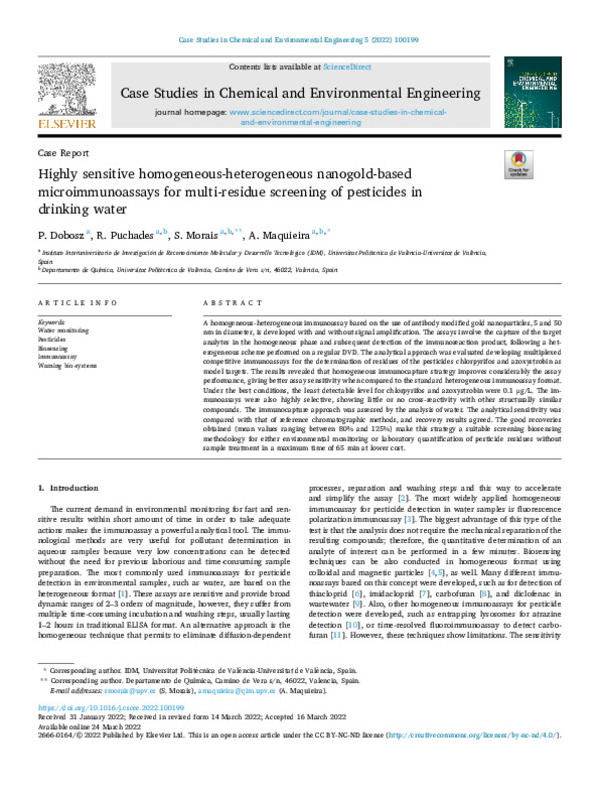JavaScript is disabled for your browser. Some features of this site may not work without it.
Buscar en RiuNet
Listar
Mi cuenta
Estadísticas
Ayuda RiuNet
Admin. UPV
Highly sensitive homogeneous-heterogeneous nanogold-based microimmunoassays for multi-residue screening of pesticides in drinking water
Mostrar el registro sencillo del ítem
Ficheros en el ítem
| dc.contributor.author | Dobosz, P.
|
es_ES |
| dc.contributor.author | Puchades, Rosa
|
es_ES |
| dc.contributor.author | Morais, Sergi
|
es_ES |
| dc.contributor.author | Maquieira Catala, Angel
|
es_ES |
| dc.date.accessioned | 2023-02-22T19:00:42Z | |
| dc.date.available | 2023-02-22T19:00:42Z | |
| dc.date.issued | 2022-04-02 | es_ES |
| dc.identifier.uri | http://hdl.handle.net/10251/192035 | |
| dc.description.abstract | [EN] A homogeneous-heterogeneous immunoassay based on the use of antibody modified gold nanoparticles, 5 and 50 nm in diameter, is developed with and without signal amplification. The assays involve the capture of the target analytes in the homogeneous phase and subsequent detection of the immunoreaction product, following a heterogeneous scheme performed on a regular DVD. The analytical approach was evaluated developing multiplexed competitive immunoassays for the determination of residues of the pesticides chlorpyrifos and azoxystrobin as model targets. The results revealed that homogeneous immunocapture strategy improves considerably the assay performance, giving better assay sensitivity when compared to the standard heterogeneous immunoassay format. Under the best conditions, the least detectable level for chlorpyrifos and azoxystrobin were 0.1 ¿g/L. The immunoassays were also highly selective, showing little or no cross-reactivity with other structurally similar compounds. The immunocapture approach was assessed by the analysis of water. The analytical sensitivity was compared with that of reference chromatographic methods, and recovery results agreed. The good recoveries obtained (mean values ranging between 80% and 125%) make this strategy a suitable screening biosensing methodology for either environmental monitoring or laboratory quantification of pesticide residues without sample treatment in a maximum time of 65 min at lower cost. | es_ES |
| dc.description.sponsorship | S.M awards grants PID2019-110713RB-I00 funded by MCIN/AEI/ 10.13039/501100011033 and by ERDF A way of making Europe. PROMETEO/2020/094, Proyecto 88/2021 Nominativa Accion 2021-12. Dr. A. Abad-Fuentes kindly provided the anti-azoxystrobin antibody and the corresponding coating conjuagte. | es_ES |
| dc.language | Inglés | es_ES |
| dc.publisher | Elsevier Ltd. | es_ES |
| dc.relation.ispartof | Case Studies in Chemical and Environmental Engineering | es_ES |
| dc.rights | Reconocimiento - No comercial - Sin obra derivada (by-nc-nd) | es_ES |
| dc.subject | Water monitoring | es_ES |
| dc.subject | Pesticides | es_ES |
| dc.subject | Biosensing | es_ES |
| dc.subject | Immunoassay | es_ES |
| dc.subject | Warning bio-systems | es_ES |
| dc.subject.classification | QUIMICA ANALITICA | es_ES |
| dc.title | Highly sensitive homogeneous-heterogeneous nanogold-based microimmunoassays for multi-residue screening of pesticides in drinking water | es_ES |
| dc.type | Artículo | es_ES |
| dc.identifier.doi | 10.1016/j.cscee.2022.100199 | es_ES |
| dc.relation.projectID | info:eu-repo/grantAgreement/AEI/Plan Estatal de Investigación Científica y Técnica y de Innovación 2017-2020/PID2019-110713RB-I00/ES/HACIA EL BIOSENSADO HOLOGRAFICO AVANZADO/ | es_ES |
| dc.relation.projectID | info:eu-repo/grantAgreement/GENERALITAT VALENCIANA//PROMETEO%2F2020%2F094//HOLOGRAFÍA. UNA VIA PARA AFRONTAR NUEVOS RETOS EN BIOSENSADO/ | es_ES |
| dc.rights.accessRights | Abierto | es_ES |
| dc.contributor.affiliation | Universitat Politècnica de València. Escuela Técnica Superior de Ingeniería Agronómica y del Medio Natural - Escola Tècnica Superior d'Enginyeria Agronòmica i del Medi Natural | es_ES |
| dc.description.bibliographicCitation | Dobosz, P.; Puchades, R.; Morais, S.; Maquieira Catala, A. (2022). Highly sensitive homogeneous-heterogeneous nanogold-based microimmunoassays for multi-residue screening of pesticides in drinking water. Case Studies in Chemical and Environmental Engineering. 5:1-5. https://doi.org/10.1016/j.cscee.2022.100199 | es_ES |
| dc.description.accrualMethod | S | es_ES |
| dc.relation.publisherversion | https://doi.org/10.1016/j.cscee.2022.100199 | es_ES |
| dc.description.upvformatpinicio | 1 | es_ES |
| dc.description.upvformatpfin | 5 | es_ES |
| dc.type.version | info:eu-repo/semantics/publishedVersion | es_ES |
| dc.description.volume | 5 | es_ES |
| dc.identifier.eissn | 2666-0164 | es_ES |
| dc.relation.pasarela | S\459980 | es_ES |
| dc.contributor.funder | GENERALITAT VALENCIANA | es_ES |
| dc.contributor.funder | AGENCIA ESTATAL DE INVESTIGACION | es_ES |
| dc.contributor.funder | European Regional Development Fund | es_ES |








